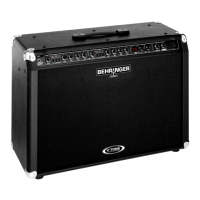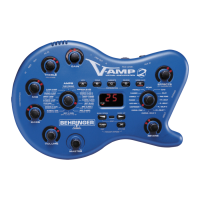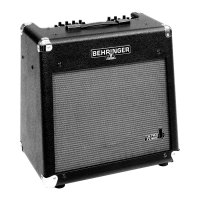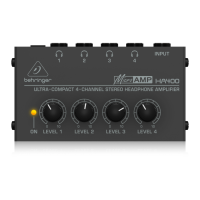13
V-TONE GMX110/GMX112/GMX210/GMX212/GMX1200H
s By turning the PRESET control, you can adjust the a
reference tone up or down in 1 Hz increments for a maximum
of 15 Hz. The last two digits of the frequency value are
always shown in the display, since the first digit is always
a 4. For example, when you start with the 440 Hz basic
tone, and then press the right arrow key four times, the
display shows 44, which corresponds to a frequency of
444 Hz.
After about 3 seconds, the display goes back to tuner mode.
Your changes are automatically stored. Ideal tones for the
remaining strings are automatically set up using the newly
adjusted frequency as a reference.
A quick hit on the CHANNEL key lets you leave tuner mode and
go back to amp mode.
6. INSTALLATION
6.1 Audio connections
With the exception of the headphone output and the AUX input
(stereo jacks), audio inputs and outputs of your BEHRINGER
V-TONE are provided in the form of mono jack connectors. Tape
inputs and outputs use RCA connectors.
+ Please keep in mind that your V-TONE should be
installed and operated only by those who possess
sufficient technical knowledge about its installation
and operation. Everyone dealing with your V-TONE
should be sufficiently grounded both during the
installation as well as during actual usage. Failure
to do so may cause undesirable or faulty operation
due to electromagnetic discharges, etc.
Fig. 6.1: 1/4" TS connector
Fig. 6.2: 1/4" stereo TRS connector for AUX and PHONES
6.2 Speaker connection
The GMX110 and GMX112 feature a SPEAKER connector to
which you can connect an additional loudspeaker. This additional
loudspeaker should be able to handle at least 30 Watts @ 4 W
(GMX110) and 60 Watts @ 4 W (GMX112) respectively.
The GMX212 and GMX1200H feature two LOUDSPEAKER-
outputs (EXT LEFT and EXT RIGHT) for connecting two
loudspeakers or a single stereo loudspeaker unit. The output
power rating is 60 W per channel. To assure optimal power
delivery from the amp, you should use 8-W loudspeakers that
can handle at least 60 Watts.
This goes for all models: You can also use loudspeakers with
higher impedance values, but this lowers proportionally the power
delivery as the resistance increases. Doubling the impedance
halves the power value (double the Ohms = half the Watts).
+ Since SPEAKER and LOUDSPEAKER outputs are
connectors where amplified signals are given out,
never connect equipment with line-level inputs to
these two connectors, e. g. mixer inputs.
6.3 MIDI connection
The MIDI standard (Musical Instruments Digital Interface) was
first developed at the beginning of the 80s, with the goal of
enabling mutual communication between electronic instruments
of various manufacturers. Over the years, the number of possible
MIDI applications has increased substantially; nowadays, it is
perfectly normal to connect entire studios via MIDI.
At the center of this network is a computer with a sequencing
software, used to control not only keyboards but also effects
processors and other peripheral equipment. In such a studio,
you can control your V-TONE in real time from a computer. Using
a MIDI footswitch presents itself as a great idea, especially in
live applications, because it allows you to control not only effect
parameters but also switch between channels and effects.
The standard 5-pole DIN MIDI connector is located on the rear of
your V-TONE. To connect your V-TONE with other MIDI equipment,
you will need a MIDI cable. Pre-packed cables
available at music stores are used for this purpose. Such cables
should not be longer than 15 m (45 ft).
MIDI IN receives MIDI control data. The receiving channel is
adjusted using the CHANNEL and IN/OUT key combination On =
Omni means that MIDI data are being received and processed on
all channels (compare section 4.2).
6. INSTALLATION

